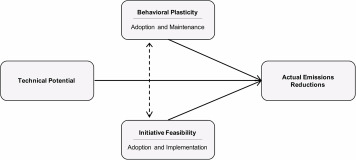A major new paper in the journal One Earth from a collaboration between U.S. and European authors on the importance of incorporating behavioral, cultural, social, and political considerations into integrated assessment models of greenhouse gas emissions pathways, especially in the context of the IPCC process.
Abstract:
Limiting global warming to 2°C or less compared with pre-industrial temperatures will require unprecedented rates of decarbonization globally. The scale and scope of transformational change required across sectors and actors in society raises critical questions of feasibility. Much of the literature on mitigation pathways addresses technological and economic aspects of feasibility, but overlooks the behavioral, cultural, and social factors that affect theoretical and practical mitigation pathways. We present a tripartite framework that “unpacks”" the concept of mitigation pathways by distinguishing three factors that together determine actual mitigation: technical potential, initiative feasibility, and behavioral plasticity. The framework aims to integrate and streamline heterogeneous disciplinary research traditions toward a more comprehensive and transparent approach that will facilitate learning across disciplines and enable mitigation pathways to more fully reflect available knowledge. We offer three suggestions for integrating the tripartite framework into current research on climate change mitigation.
Why the Human Factor Is so Important
The vast majority of integrated assessment models used to study possible future greenhouse gas emissions pathways focus on technological-economic models in which emissions are driven by a combination of economic activity (which drives production and consumption of goods and services) and technological innnovation, which drives trends in the energy-intensity and greenhouse-gas emissions intensity of economic activity. These models generally reduce human decision-making and behavior to a quasi-rational effort to maximize consumption.
In fact, we know very well that human behavior is far more complex and reducing it to its purely economic aspects misses important aspects of behavior. Moreover, the possibilities for changing the world’s emissions trajectory depends strongly on what is politically possible. Many of the policy measures favored by both economists and activists, such as taxing emissions, face daunting political obstacles that have prevented them from being seriously considered by policymakers.
Three-Part Analysis Framework
In this paper, we argue that a three-part analysis framework that Mike Vandenbergh and I have been advocating, can be helpful in improving the analysis and modeling of future greenhouse gas emissions. This framework considers emissions reduction in terms of technical potential (TP), behavioral plasticity (BP), and initiative feasibility (IF).

Technical potential refers to the emissions reduction that a an action would produce if everyone who could take it did so. For instance, if everyone who could do so would commute to and from work by carpool or public transit.
Behavioral plasticity refers to the fraction of people who would choose to take an action. Even when it is possible to do so, very few people will choose to carpool or use transit. This causes actual emissions reductions to be less than the technical potential in most cases. Behavior can be influenced by a variety of factors, such as economic incentives (e.g., rebates, tax breaks, or other subsidies for buying an electric car), marketing, convenience (making it easier to use an alternate means of commuting), and social influences (e.g., peer pressure from friends, family, co-workers, etc. to use carpools or public transit). Policies that recognize and address obstacles to behavior change are likely to be more effective than those that don’t.
Initiative feasibility refers to the political obstacles to enacting and implementing new environmental policies. There is broad agreement among most economists—both liberal and conservative—that charging a price for greenhouse gas emissions, either through carbon taxes or tradeable permits, would have a powerful effect in reducing emissions, but these policies are very controversial and have encountered powerful opposition, not only in the United States, but throughout the world, as we have seen in Australia’s repeal of its emissions-pricing law in 2014, or in the gilets jaunes uprising in France against President Macron’s emission-pricing policy.
Incorporating the Framework into Integrated Assessment Models
In many cases, empirical research allows us to make quantitative estimates of BP, but in other cases there isn’t data and it becomes necessary to use guesswork to estimate BP by analogy to areas where there is data.
Initiative feasibility is even more difficult and there are no reliable methods for quantitatively assessing the probability of enacting a new policy or the effectiveness that policy is likely to have in practice.
Future modeling studies will need to contend with the difficulty of assessing BP and IF. We suggest that initially, expert elicitation or survey methods may be able to provide exogenous estimates of BP and IF, but we observe that both BP and IF are context dependent, so it would be especially valuable if modelers can find ways to treat these endogenously.